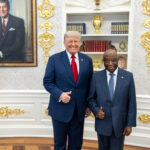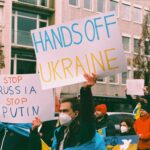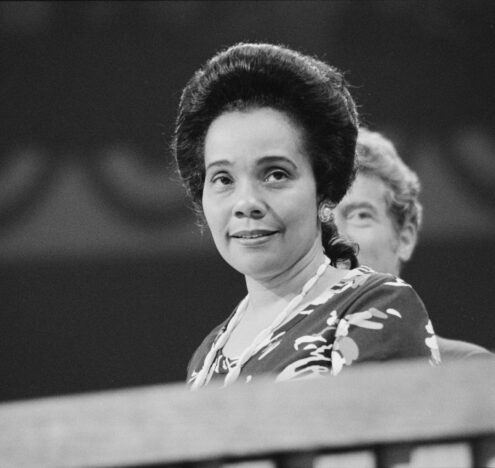Every August brings peak tourist season to Washington. Hordes of families and school groups swarm Capitol Hill and the Mall, drawing groans for standing on the left of the Metro escalators, and taking on that distinctive, melted raspberry sorbet look that seizes so many of DC’s summer visitors.
Many of those travelers will crowd into the Smithsonian Air and Space Museum. They will focus on marvels like the Spirit of St. Louis and the Bell X-1 and the Wright Brothers’ flyer.
Most of them will stream right past the pair of rockets just inside the museum’s Mall-side entrance. One is olive green with bold, black “US ARMY” down the side. The other is larger, with strange, Cyrillic-filled yellow grids broken up by green stripes and topped by an odd, three-headed tip.
My son does not get to speed by those missiles.
His dad works on reducing nuclear weapons threats, so my son has to stop and learn that the rocket on the right was something called a Pershing II missile. It could fly from here to about Colorado.
He hears that the one on the left was what our country called the SS-20 Saber. It was owned by a country that included what is now Russia but that we called the Soviet Union. That missile could fly from here to Alaska.
My son learns that, if just one of the bombs that used to sit on top of those missiles had gone off above where we’re standing, then pretty much everything he can see — from the Washington Monument to the Capitol — would have been reduced to radioactive rubble.
If one of those bombs had gone off, the two of us, and just about everyone we can see, would have likely died.
My son hears that America used to have around a hundred missiles like that Pershing II based in central Europe. They were there because beginning in the late 1970s, the Soviet Union fielded several hundred of those three-headed monsters on the left, scaring the heck out of our country and a bunch of our European friends who are in a club with us that we call the North Atlantic Treaty Organization.
We and our NATO friends agreed to answer those Soviet SS-20’s with a “dual-track” strategy. NATO would build up its own mid-size nuclear missiles like that Pershing II. At the same time, Washington would try to talk with Moscow about what they needed to do to stop scaring us with that SS-20.
Our army first fielded those Pershing II missiles in what was called West Germany in November 1983.
I was eight years old.
Four long, sometimes harrowing years followed. The American president got reelected. Two Soviet leaders died. What my son calls “the KC Team” won its first World Series. The Americans and the Soviets had lots of starts and stops in talking about all those missiles.
At long last, in December 1987, our president — Ronald Reagan — and the Soviet leader — Mikhail Gorbachev — clinched a deal to get rid of all the missiles like those two in the museum. Most people refer to that deal as the Intermediate-Range Nuclear Forces, or INF, Treaty, even though both countries agreed to destroy all the ground-launched missiles they owned that could fly about as far as those two missiles, whether they carried nuclear explosives or not.
I tell my son that both sides promised to never build these kinds of missiles again.
Russia started breaking that promise — and bleeding the INF Treaty to death — sometime around a decade or so ago. It secretly built, tested, and then deployed mobile ground-launched nuclear-capable cruise missiles designed to fly the range prohibited by the treaty. My past work in the US Government let me see some of what led it to accuse Russia of breaking its treaty promise. You need not — indeed, you should not — simply trust assertions of a government insider. But I have no doubt that Russia has cheated.
The United States had to figure out how to respond. The Obama administration tried to build pressure on Russia to get it to stop — but it also tried really hard to leave a way for Russia to come back into compliance.
Russia’s answer at every turn amounted to, “What missile? What violation? And what about all your actions we say are violations?”
The Trump administration took a new approach. The governments of those same European NATO friends really hoped to save the deal; it had seriously eased their nuclear worries for three decades. So the Trump administration at first pitched a plan to essentially try to save INF by starting treaty-allowed work on our own INF-killing missiles.
But by the late fall of 2018, with John Bolton ever more confident in his role as President Trump’s national security adviser, the administration lost patience with pretending that it thought the treaty could or should be saved. President Trump announced at a campaign rally that the United States would formally quit the INF Treaty.
For eight-year-old me, that movie was real. I was watching in northeastern Oklahoma, and I visited my two grandmothers in Kansas all the time. That could really happen.
On Friday, August 2, the United States legally withdrew from the INF Treaty, and the deal that has been making those two monoliths collect dust in a museum has itself now been dropped into history’s dustbin. Trump administration officials have also confirmed that sometime in the coming weeks or months, the United States will test-launch a once-forbidden intermediate-range cruise missile from a truck and will “fully pursue” development of these kinds of missiles.
That is how this year’s August in DC brought tourists, and brought the final death of a treaty.
I don’t have the heart to take my son back to Air and Space right now.
Today, it’s my son who is eight years old.
Russian and American diplomats seem eager to tell me that it’s the other side’s fault. I don’t really care. What I care about is the plan for getting those damned things back in museums where they belong.
I don’t actually remember those missiles rolling out in November 1983. What I do remember from that month is watching “The Day After,” the TV movie that imagined what it would be like in Kansas if a nuclear war really did break out (after tensions erupted between West and East Germany, no less).
For eight-year-old me, that movie was real. I was watching in northeastern Oklahoma, and I visited my two grandmothers in Kansas all the time. That could really happen. Those missile launch streaks really could climb up into the sky. That bright flash on the shoulder of the road really could happen. That menacing poison snow really could fall.
I wasn’t the only one who felt that way: an estimated 100 million Americans sat down together that night to watch. We all lived daily with the fear that nuclear war could happen tomorrow.
What I would not have believed then — what I would not have bet on in a million years — was that some three and half decades later the world would be so much safer for me, and that nuclear war fears would be so much lighter. But it is, and they are. There are far, far fewer nuclear weapons around us today. There is far less military hardware and there are far fewer soldiers arrayed around far softer lines of division in Europe today than there were then. There is no comparing how much more easily normal Russians, Americans, and Chinese can interact with one another today.
In short, I face a far safer nuclear world today as an adult than I did as an eight-year-old. The INF Treaty is a big part of the reason why.
Many who tout the value of leaving the INF Treaty today will probably tell you that it was those American missiles in the 1980s that convinced a refreshingly different kind of Soviet leader to finally give up those SS-20’s. I’ll buy that they helped. It sure as hell also took a lot of luck for things to turn out so well.
But one thing we can say for sure is that pressure alone would not have been enough. Pressure might have teed things up, but it alone didn’t knock them into place. More than anything else the world needed two things to get us from there to here: hard work, and hard compromise.
The truth is, the Reagan and Bush administrations worked their tails off in negotiating very difficult, very complicated agreements with a regime in Moscow that they still thought of as their intractable enemy. When those administrations were negotiating the long, complex, and very detailed treaty texts that would become the 1987 INF Treaty, or the 1990 Treaty on Conventional Armed Forces in Europe, or the original 1991 Strategic Offensive Reduction Arms, or START, Treaty, they didn’t know that our long-time, implacable Soviet foe would suddenly and shockingly break apart at the end of 1991. They took negotiated agreements seriously, they worked hard at them, and they were prepared to accept reasonable restraints on the United States when doing so secured other American national priorities.
The death of the INF Treaty, or the Trump administration’s cavalier dismissal of the value of the New START Treaty, or even the calls to build new ground- and sea-launched cruise and ballistic missiles won’t push us back overnight into my much scarier, eight-year-old world. The downside of that overused phrase “arms race” is that it focuses people on the pace. It is not the speed of events today that should scare us.
What should scare us is that Moscow and Beijing and, yes, Washington today seem more and more interested in just brandishing more arms and pointing more fingers, and less and less interested in all that boring talk, work, and compromise business.
So maybe “arms quicksand” is a better descriptor for what we risk now: it might take time for things to get moving, but those attitudes will suck us down again all the same.
What is worse, here in Washington today it feels harder and harder to find voices in the party of Reagan and Bush who are willing and able to mimic those two presidents’ dogged readiness to use negotiated agreements to secure American security aims even when it means accepting some restraints on us as well. At times it seems that, for most of those who today publicly bear the banner of the party of James Baker and George Shultz and Richard Lugar, the only acceptable answer for a bad guy with nukes is good guys with more nukes. (Senator Todd Young of Indiana, Representative Mike McCaul of Texas, and a handful of others stand out as welcome, courageous exceptions to that trend.)
That approach might feel easy and satisfying at first, but all too soon it will get us sucked back down into that 1983 world again.
It is easy to wreck and it is hard to build. There was a lot that got built for me from the time I was eight. I don’t want all those things to start getting wrecked now that it’s my son who is the eight-year-old.
Something else happened that November of 1983 that I don’t actually remember. That was the month Ronald Reagan told the Japanese parliament something he hadn’t said publicly before: that “a nuclear war can never be won and must never be fought.”
Folks like me who work on reducing nuclear dangers have made that quote do a lot of work over the years.
But today, with one grand old nuclear treaty dead and the days now numbered on its younger New START cousin, with Russia and China’s rulers seemingly looking for new weapons here, there, and everywhere to fill up their own holes of regime insecurity, it is worth keeping in mind something else Reagan said in that November speech in Japan.
“The United States,” Reagan assured our allies and the world that day, “will never walk away from the negotiating table. Peace is too important.”
Reagan was right. It’s time to sit back down at the table and get back to work. We saw some wrecking this August, and now we need to see some building. My eight-year-old is counting on it. So am I.
Anthony Wier is legislative secretary for nuclear disarmament and Pentagon spending at the Friends Committee on National Legislation.




















